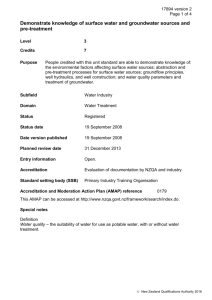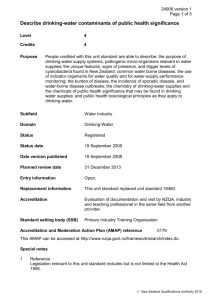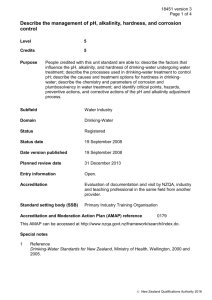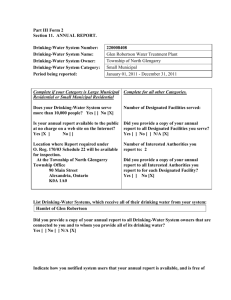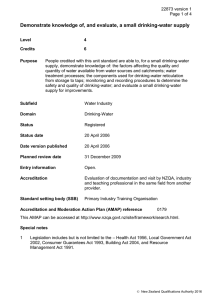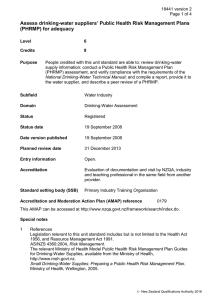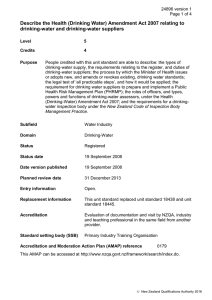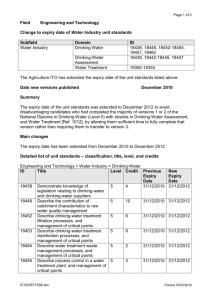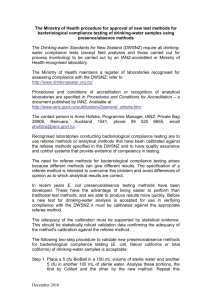24897 Describe the contribution of catchment characteristics
advertisement
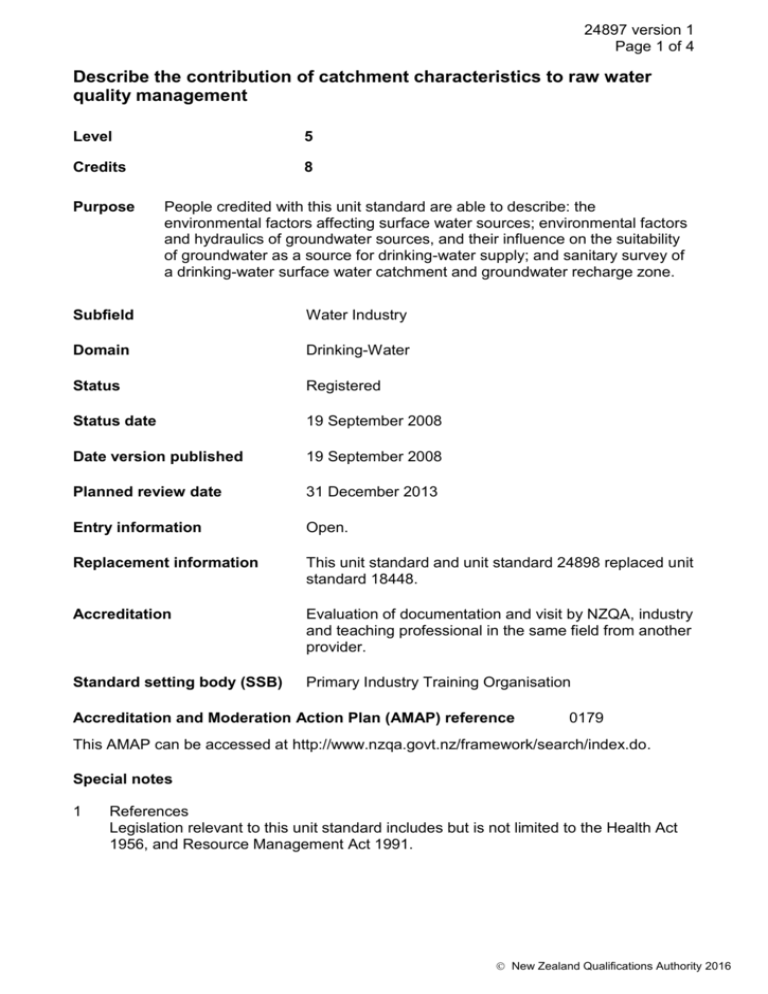
24897 version 1 Page 1 of 4 Describe the contribution of catchment characteristics to raw water quality management Level 5 Credits 8 Purpose People credited with this unit standard are able to describe: the environmental factors affecting surface water sources; environmental factors and hydraulics of groundwater sources, and their influence on the suitability of groundwater as a source for drinking-water supply; and sanitary survey of a drinking-water surface water catchment and groundwater recharge zone. Subfield Water Industry Domain Drinking-Water Status Registered Status date 19 September 2008 Date version published 19 September 2008 Planned review date 31 December 2013 Entry information Open. Replacement information This unit standard and unit standard 24898 replaced unit standard 18448. Accreditation Evaluation of documentation and visit by NZQA, industry and teaching professional in the same field from another provider. Standard setting body (SSB) Primary Industry Training Organisation Accreditation and Moderation Action Plan (AMAP) reference 0179 This AMAP can be accessed at http://www.nzqa.govt.nz/framework/search/index.do. Special notes 1 References Legislation relevant to this unit standard includes but is not limited to the Health Act 1956, and Resource Management Act 1991. New Zealand Qualifications Authority 2016 24897 version 1 Page 2 of 4 Ministry of Health Public Health Risk Management Plan Guides for Drinking-Water Supplies (PHRMPGs): S1.1, Surface and groundwater sources; S2, Development of new supplies; P11, Surface water abstraction – rivers, streams and infiltration galleries; P4.2, Destratification. Drinking-Water Standards for New Zealand, Ministry of Health, Wellington, 2000 and 2005. Guidelines for Drinking-Water Quality Management for New Zealand, Ministry of Health, Wellington, 2005, Chapter 3.4.2. Proposed/National Environmental Standard for Human Drinking-water Sources, Ministry for the Environment, available from http://www.mfe.govt.nz. 2 Definitions Critical points – points in a process or in equipment where failure to function correctly can lead to a public health hazard. Water quality – the suitability of water for use as drinking-water, with or without water treatment. Drinking-water supply – the supply catchment, treatment plant, and distribution. The drinking-water supplier has responsibility for managing the public health risks of the drinking-water supply. Elements and performance criteria Element 1 Describe the environmental factors affecting surface water sources. Performance criteria 1.1 Surface water environments are described in terms of their suitability as sources for drinking-water supply. Range 1.2 Surface water sources are identified and described in terms of the constraints of the natural and regulatory environment. Range 1.3 lakes, raw water storage, upland rivers and streams, lowland rivers and streams, off-river storage. includes but is not limited to – river/stream topography and hydrology, water quality, stream bed movement, contamination sources, resource consents, catchment land use, recreational use, intake security, eutrophication, aquatic life, lithology, stratification; impact of vegetation – colour type; soil type, rock type, catchment site. The changes in surface water quality under different flow regimes are described in terms of the physical and chemical parameters. Range includes but is not limited to – turbidity, particulate matter, silts and clays, alkalinity, organic colour, natural organic matter, microorganisms, flow, weather patterns. New Zealand Qualifications Authority 2016 24897 version 1 Page 3 of 4 Element 2 Describe environmental factors and hydraulics of groundwater sources, and their influence on the suitability of groundwater as a source for drinking-water supply. Performance criteria 2.1 Groundwater environments are described in terms of their suitability as sources for drinking-water supply. Range 2.2 Well hydraulics is described in terms of different flow rates. Range 2.3 includes but is not limited to – drawdown, cone of depression, piezometric head, observation bore, artesian water, springs, permeability and hydraulic capacity. The changes in groundwater quality with time are described in terms of their physical, chemical and microbiological parameters. Range 2.4 includes but is not limited to – gravels, sands, fractured rock, infiltration zones, recharge areas, aquicludes, confined and unconfined aquifers. includes but is not limited to – turbidity reduction, microbiological removal and die-off, ammonia, pH, carbon dioxide, hydrogen sulphide, iron and manganese solubility, nitrates, carbonates, sulphates, chlorides. Groundwater and bore security are identified and described in terms of the constraints of the natural environment. Range includes but is not limited to – surface infiltration, borehead construction and protection, groundwater security criteria, proximity of other bores. Element 3 Describe sanitary survey of a drinking-water surface water catchment and groundwater recharge zone. Performance criteria 3.1 Information sources are identified and consulted relevant to the sanitary survey of the drinking-water supply. Range topographical maps, land use maps, soil maps, regional and district plans, resource consents, site detail by site inspection. New Zealand Qualifications Authority 2016 24897 version 1 Page 4 of 4 3.2 Critical points in catchment, abstraction process, treatment plant and distribution system of a drinking-water supply are identified. Range water source – surface water, groundwater; existing and potential sources of contamination, impacts from different land uses, potential future activities, resource consents, regional and district plans. 3.3 Methods for assessment of critical points are described in terms of the likelihood of contamination of the raw water. 3.4 Assessment of contamination of water source is described in terms of the role of sampling. Range 3.5 chemical sampling, microbiological sampling, limitations of information provided by sampling. Recording and reporting procedures for results are described. Range risks and their implications identified, significance of risk evaluated, resource material referenced. Please note Providers must be accredited by NZQA, or an inter-institutional body with delegated authority for quality assurance, before they can report credits from assessment against unit standards or deliver courses of study leading to that assessment. Industry Training Organisations must be accredited by NZQA before they can register credits from assessment against unit standards. Accredited providers and Industry Training Organisations assessing against unit standards must engage with the moderation system that applies to those standards. Accreditation requirements and an outline of the moderation system that applies to this standard are outlined in the Accreditation and Moderation Action Plan (AMAP). The AMAP also includes useful information about special requirements for organisations wishing to develop education and training programmes, such as minimum qualifications for tutors and assessors, and special resource requirements. Comments on this unit standard Please contact the Primary Industry Training Organisation standards@primaryito.ac.nz if you wish to suggest changes to the content of this unit standard. New Zealand Qualifications Authority 2016
